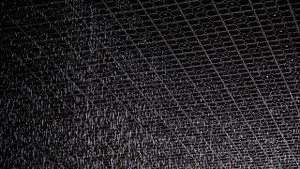Rain Room

Date: 2012
Artist: rAndom international
Medium: Instillation
Link: http://random-international.com/work/rainroom/
Rain Room
Formal Analysis
Rain Room is an interactive instillation created by the Hannes Koch, Stuart Wood and Florian Ortkrass as rAndom international. The instillation transforms the indoors into the outdoors through the creation of a digitalized simulation of the sounds, humidity and visual experience of rainfall. [1]Through the space, viewers are able to navigate themselves along a self-created path and experience the phenomenon of heavy downpour without getting wet. The experience of Rain Room is that the viewer feels the sense of the rain through the moisture in the air and the sounds of falling rain before actually being confronted with the rainfall that is respondent to the viewers movements and presence.[2] The instillation is heavily focused on human reaction and action, as the mechanisms in place are reliant on audience participation and interaction for it's display. rAndom international describes their instillation as a social experiment designed to extract personality types. The interaction based instillation becomes a people-watching space in which the viewer's reaction performance differs from day to day. [3]
Exhibition Techniques
Rain Room is a hundred square square metre room that was first installed in the Barbican's exhibition space known as The Curve.[4] The room is an interactive space in which viewers are able to walk through to initiate the performance. The indoor rainfall is created through the use of water, injection moulded tiles, solenoid valves, pressure regulators, custom software, 3D tracking cameras, steel beams, a water management system, and a grated floor. [5] A set of cameras that 3D map the location and movement of bodies translates information into a pixelated grid of panels, each 25 squared centimeters in dimension. The panels work together to control a set of outlets that release 1,000 litres of water per minute. As the water falls, it is filtered and treated through a plumbing system to be recycled back into the rainfall. [6]The mechanisms in place make it so that the audience has to walk through the space slowly and tentatively, which allows for slower and deeper consideration of the work.[7]
Acceptance of the Work
Rain Room has been a widely popular installation at both the Barbican in London and at the MoMA in New York City. It's popularity attracted lines out the door at that reached up to 5 hours in visitor waiting time.[8] Because of its captivating sensory-intense experience, Rain Room became one of 2013's most popularly "Instagrammed" art installations, tracked with the hashtag #RainRoom on Instagram.[9]
References
- ↑ http://www.digitalmeetsculture.net/article/rain-room-at-londons-barbican/
- ↑ http://random-international.com/work/rainroom/
- ↑ http://random-international.com/wp-content/uploads/2012/10/20121003-huffingtonpost-power-over-rain.pdf
- ↑ http://www.digitalmeetsculture.net/article/rain-room-at-londons-barbican/
- ↑ http://random-international.com/work/rainroom/
- ↑ http://random-international.com/wp-content/uploads/2012/11/20121003-designboom_-FF-RR-BARB-UK1.pdf
- ↑ http://random-international.com/wp-content/uploads/2012/11/20121005-Onestoparts.com-FF-RR-BARB-US_sml.pdf
- ↑ http://www.businessinsider.com/moma-rain-room-not-worth-the-wait-2013-7
- ↑ http://random-international.com/wp-content/uploads/2013/12/2013s-Most-Instagrammed-Art-Installations.pdf
